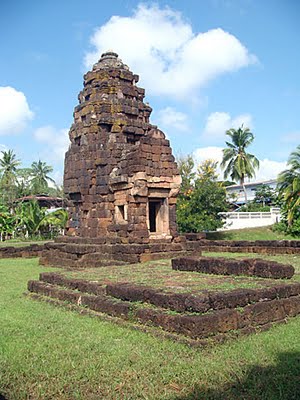 The central laterite tower at Kuti Rishi Ban Nong Bua Lai, with the foundations of the library in the foreground
The central laterite tower at Kuti Rishi Ban Nong Bua Lai, with the foundations of the library in the foreground
Jayavarman VII was a fervent Buddhist as well as the greatest builder of the Khmer Empire. His determination to leave his mark included the construction of 102 hospitals (built in wood and long since disappeared) across his vast empire and with each of those hospitals came a chapel for religious purposes. There are a handful of chapels to be found in Isaan, and two of them both with the name
Kuti Rishi, or hermit cell, are within a short distance of Prasat Phnom Rung and its nearby sister temple Prasat Muang Tam. They are identical in appearance, composed of hard laterite stone with a typical layout of a central redented tower, a southern library with a laterite rectangular enclosure wall and a single east-facing gopura with doors and windows made of sandstone. Next to each is a laterite-lined pond. There aren't any lintels or carvings to shout about though both of the Kuti Rishi are worth a stop en route between the two main temple sites for their peaceful locations.
Kuti Rishi Ban Nong Bua Lai is the one closest to Phnom Rung, lying at the foot of the hill and near a large baray of the same name. It's a little more of a ruin than its sister, with its library no longer standing and much of its enclosing wall long since gone. Three young girls provided us with some entertainment as they practised jumping into the pond before they were scolded by their grandmother for not getting on with washing the family clothes. About five kilometres away and next to the baray of Prasat Muang Tam is the second hermit cell,
Kuti Rishi Ban Khok Muang. It was devoid of any life, set on its own in fields, though was well maintained and alongwith a few antefixes on the seven metre tall laterite tower, I also spotted a couple of sandstone pedestals.
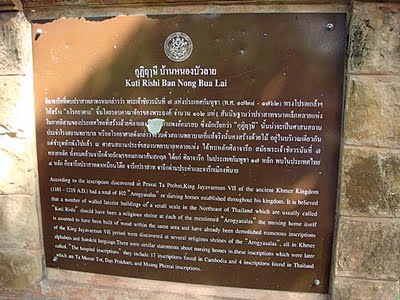 The informative introduction sign at Kuti Rishi Ban Nong Bua Lai
The informative introduction sign at Kuti Rishi Ban Nong Bua Lai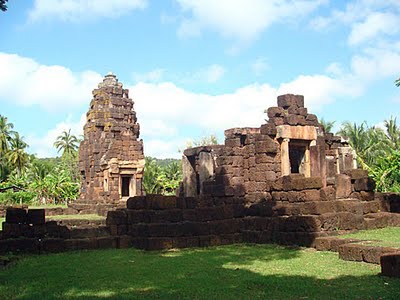 The broken wall allows a good view of the tower and gopura at Kuti Rishi Ban Nong Bua Lai
The broken wall allows a good view of the tower and gopura at Kuti Rishi Ban Nong Bua Lai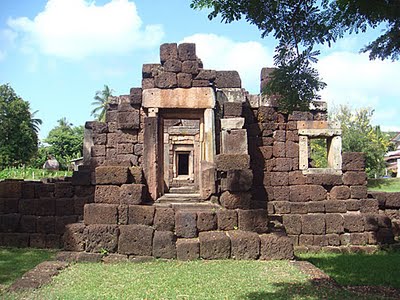 The ruined eastern gopura at Kuti Rishi Ban Nong Bua Lai
The ruined eastern gopura at Kuti Rishi Ban Nong Bua Lai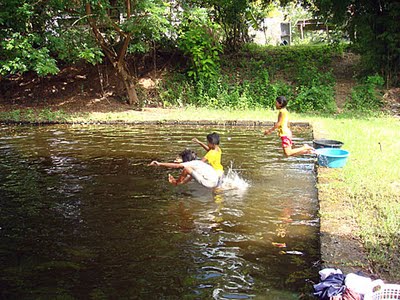 The girls carry on their practice dives into the pond despite scolding from their grandmother
The girls carry on their practice dives into the pond despite scolding from their grandmother
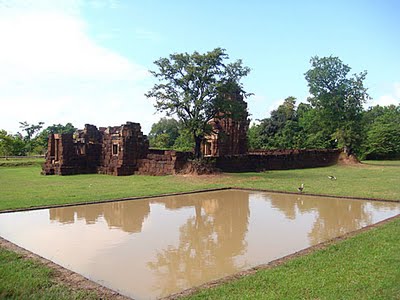 The pond and temple of Kuti Rishi Ban Khok Muang
The pond and temple of Kuti Rishi Ban Khok Muang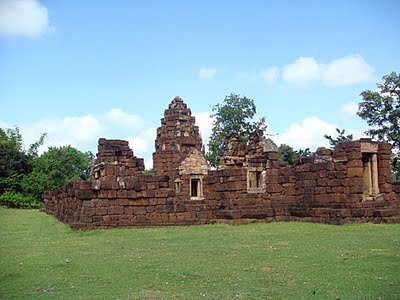 The central tower and gopura of the Kuti Rishi near the baray of Muang Tam
The central tower and gopura of the Kuti Rishi near the baray of Muang Tam
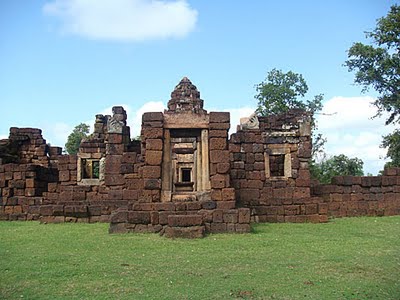 The east-facing gopura at Kuti Rishi Ban Khok Muang
The east-facing gopura at Kuti Rishi Ban Khok Muang
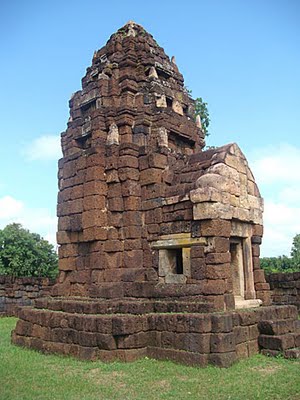 The central laterite tower at Kuti Rishi Ban Khok Muang with sandstone antefixes in situ
The central laterite tower at Kuti Rishi Ban Khok Muang with sandstone antefixes in situ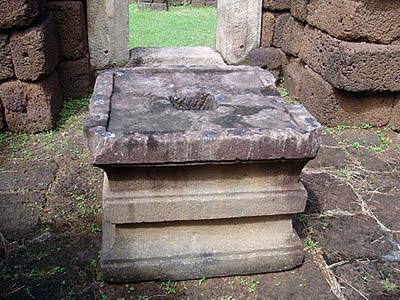 A sandstone pedestal in the gopura at Kuti Rishi Ban Khok Muang
A sandstone pedestal in the gopura at Kuti Rishi Ban Khok MuangLabels: Isaan, Kuti Rishi, Prasat Muang Tam, Prasat Phnom Rung
 The central laterite tower at Kuti Rishi Ban Nong Bua Lai, with the foundations of the library in the foreground
The central laterite tower at Kuti Rishi Ban Nong Bua Lai, with the foundations of the library in the foreground The central laterite tower at Kuti Rishi Ban Nong Bua Lai, with the foundations of the library in the foreground
The central laterite tower at Kuti Rishi Ban Nong Bua Lai, with the foundations of the library in the foreground
3 Comments:
Dear Andy,
I noticed some devatas, or guardian godesses, are figured holding what seems a whip or a snake in one of their hands; do you know pecisely what it is? I guess, t'is something like the shell, wheel of the law, fish and other auspicious signs with with the Hindu deities are often depicted, but I'm not sure. Could you please recommend me some book or publication on Khmer art where I could find a key to these symbols? Thank you, very much, for any help and congratulations for your great blog! - Miranda
Hi Miranda,
i think most of them if they are holding something, its usually some flower stems or fan, or even their dress, and usually up in the air. Some look as though they are holding something lower down (their hand is near their navel) but that is usually a panel of their dress/costume I believe rather than a snake or whip (but I could be wrong).
I am not the definitive person to ask about this and would recommend this website for more details, and to ask questions.
http://www.devata.org/
There's a book called Khmer Costumes & Ornaments - Of the Devatas of Angkor Wat by Sappho Marchal, which is available as a reprint, translation by Merrily Hansen.
Andy
Usually Nagas (snake kings) frame the upper part of the niches in which the Devatas are posted. The best to be seen in Ta Som, Angkor. I have nerer seen a Naga in the hand of a Devata. As to the Naga, see http://www.angkorguide.net/mythology/naga_garuda.htm
Post a Comment
<< Home